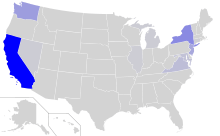Punjabi diaspora
The Punjabi diaspora refers to the descendants of ethnic Punjabis who emigrated out of the Punjab region in the northern part of the Indian subcontinent to the rest of the world. Punjabis are one of the largest ethnic groups in both the Pakistani and Indian diasporas. The Punjabi diaspora numbers around 10 million, mainly concentrated in Britain, North America, Southeast Asia and the Middle East.[1]
| Total population | |
|---|---|
| 120 million[1] | |
| Languages | |
| Punjabi and its dialects • English | |
| Religion | |
| Related ethnic groups | |
| Indian Diaspora, Sikh diaspora, Pakistani diaspora, South Asian Diaspora |
Afghanistan
Australia
Punjabis migrated to Australia from other parts of the Punjabi diaspora, as well from the state of Punjab itself. The Majority were Sikh & Hindu Punjabis instead of Muslims being the minority.[2]
Canada
85% of Indo-Canadians in British Columbia are Punjabi Sikhs,[3] including former premier of British Columbia, Ujjal Dosanjh.
Hong Kong
Among Hong Kong Indian adolescents, Punjabi is the third most common language other than Cantonese.[4] The Punjabis were influential in the military, and in line with the British military thinking of the time (namely, the late 19th century and early 20th century) Punjabi Sikhs, Punjabi Hindus and Punjabi Muslims formed two separate regiments. The regiments were as follows:
- Punjab regiment: 25,000 soldiers (50% Muslim, 40% Hindu and 10% Sikh)
- Sikh Regiment: 10,000 soldiers (80% Sikh, 20% Hindu)
In 1939, Hong Kong's police force included 272 Europeans, 774 Indians (mainly Punjabis) and 1140 Chinese.[5] Punjabis dominated Hong Kong's police force until the 1950s.[6]
From the 2006 Government by-census results, it shows a population of roughly 20,444 Indians and roughly 11,111 Pakistanis residing at the former British territory.[7]
Iran
Around 60 Punjabi Sikh families resides in Iran.[8] Punjabi language is also taught at Kendriya Vidyalaya Tehran, an Indian co-educational school in Baharestan District, Tehran.[9]
Japan
There are 71,000 Punjabis. In Japan 98% of the Punjabis are Muslim and 1.5% of the Punjabis are Christian.[10]
Kenya
Most Kenyan Asians are Gujaratis, but the second largest group are Punjabis.[11] All three major religious groups (Sikh, muslim and Hindu) are represented in the Punjabi population.The artisan Ramgharia used to be the largest group amongst the sikh.[12]
Malaysia
Although most Malaysian Indians are Tamils, there were also many Punjabis that immigrated to Malaysia. According to Amarjit Kaur as of 1993 there were 60, 000 Punjabis in Malaysia.[13] Robin Cohen estimates the number of Malaysian Sikhs as 30, 000 (as of 1995).[5] Recent figures state that there are 130,000 Sikhs in Malaysia.[14]
New Zealand
In New Zealand, Punjabis are one of the largest group of Indian New Zealanders.[15]
Persian Gulf states
In the Gulf states, the largest group among Pakistani expatriates are the Punjabis.[16]
Singapore
The third largest group among Indo-Singaporeans in 1980 were Punjabis (after Tamils - who form a majority of Indo-Singaporeans - and Malayalis), at 7.8% of the Indo-Singaporean population.[17]
Thailand
Most Indians in Thailand are Punjabis.[18]
United Kingdom
In the United Kingdom, around two-thirds of direct migrants (excluding South Asians that immigrated from the Caribbean, Fiji and other regions) from South Asia were Punjabi. The remaining third is mostly Gujarati and Bengali.[19] They form a majority of both the South Asian British Sikh and Hindu communities.
Most "twice-migrants" were also Punjabi or Gujarati.[20]
United Kingdom is also known as the birth place of bhangra music, a style of non traditional Punjabi music created by the Punjabi diaspora.
United States

The earliest South Asian immigrants to the United States were Punjabis, who mostly immigrated to the West Coast, particularly California.[21] Half of Pakistani Americans are Punjabis.[22] 85% of the early Indian immigrants to the US were Sikhs, although they were branded by White Americans as "Hindus".[23] 90% of Indians who settled in the Central Valley of California were Punjabi Sikhs.[24]
References
- http://apnaorg.com/articles/ishtiaq8/ - Punjabis Without Punjabi
- Tony Ballantyne. Between Colonialism and Diaspora: Sikh Cultural Formations in an Imperial World.
- Mahendra Gaur. Foreign policy annual. p. 317.
- Martha Carswell Pennington (1998). Language in Hong Kong at Century's End. Hong Kong University Press. p. 219.
- Robin Cohen (1995). The Cambridge Survey of World Migration. Cambridge University Press. p. 70.
- Carol R. Ember; Melvin Ember; Ian A. Skoggard (2004). Encyclopedia of Diasporas: Immigrant and Refugee Cultures Around the World. Volume I: Overviews and Topics; Volume II: Diaspora Communities. Springer.
- Hong Kong SAR Government (2007). Census and Statistics Department 2006 Population By-census: Section A, Table A105. Hong Kong SAR Government.
- Chaudhury, Dipanjan Roy (20 May 2016). "Prime Minister Narendra Modi to visit Iran Gurdwara" – via The Economic Times.
- "International Schools in Tehran: Indian KV School". December 7, 2017.
- Project, Joshua. "Punjabi in Japan".
- Wilfred Whiteley. Language in Kenya.
- Roger Sanjek (11 November 2014). Mutuality: Anthropology's Changing Terms of Engagement. University of Pennsylvania Press. p. 87. ISBN 978-0-8122-9031-8.
- Amarjit Kaur (1993). Historical Dictionary of Malaysia. Scarecrow Press.
- "Punjabis Without Punjabi". apnaorg.com.
- "Indians - Indian communities - Te Ara Encyclopedia of New Zealand".
- Ayesha Jalal (1995). Democracy and Authoritarianism in South Asia: A Comparative and Historical Perspective. Cambridge University Press.
- Language Change Via Language Planning: Some Theoretical and Empirical Aspects with a Focus on Singapore. p. 77.
- Kernial Singh Sandhu; A. Mani. Indian Communities in Southeast Asia.
- Roger Ballard, Marcus Banks (1994). Desh Pardesh. C. Hurst & Co. Publishers. pp. 19–20.CS1 maint: uses authors parameter (link)
- Peter J. Claus; Sarah Diamond; Margaret Ann Mills. South Asian Folklore: An Encyclopedia : Afghanistan, Bangladesh, India, Nepal, Pakistan, Sri Lanka. p. 158.
- Parmatma Saran, Edwin Eames. The New Ethnics: Asian Indians in the United States.CS1 maint: uses authors parameter (link)
- http://www.everyculture.com/multi/Le-Pa/Pakistani-Americans.html - Under "Language"
- David M. Reimers (2005). Other Immigrants: The Global Origins of the American People. NYU Press. p. 61.
- Margaret A. Gibson (1988). Accommodation Without Assimilation. Cornell University Press. p. 2.

